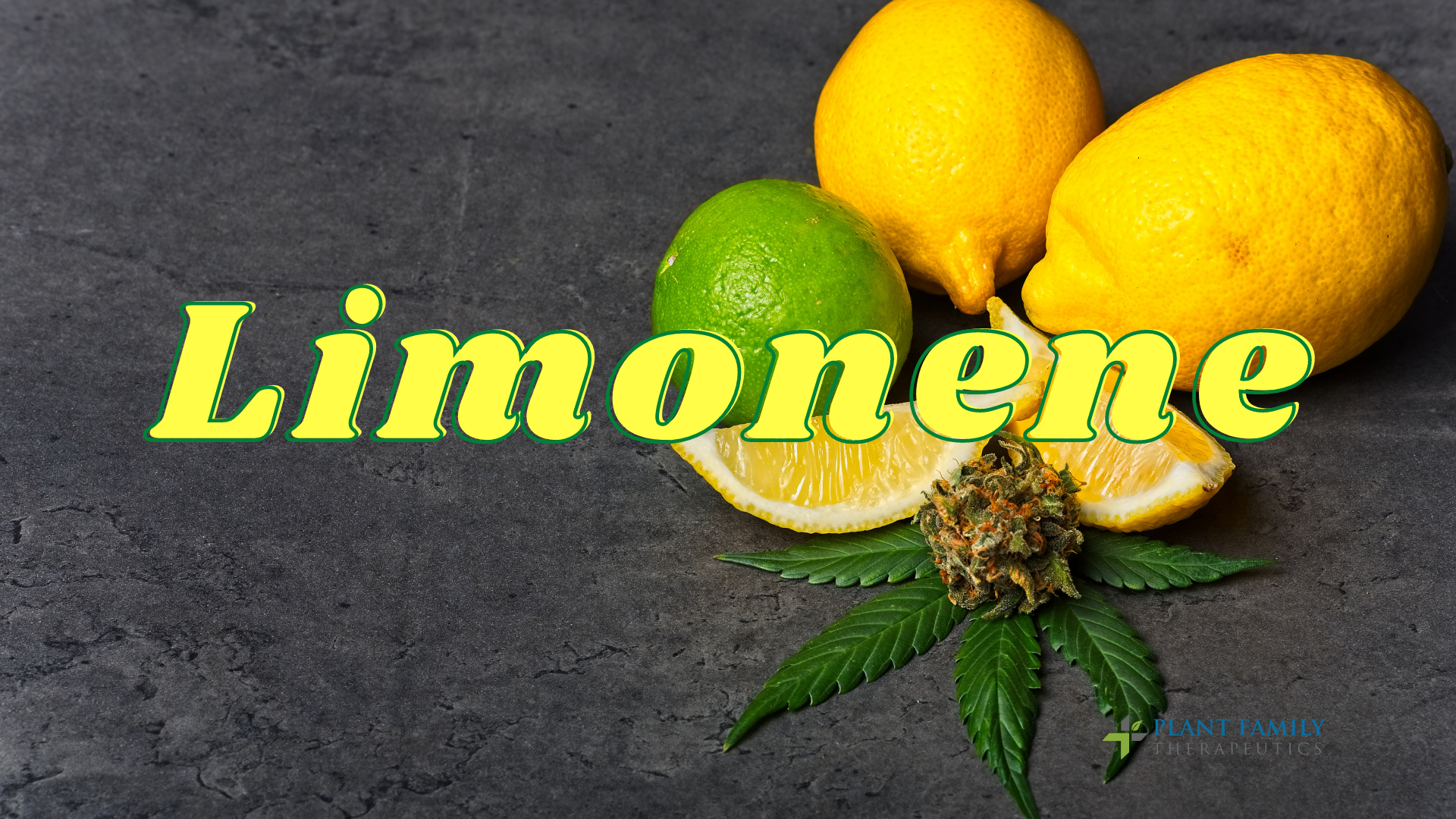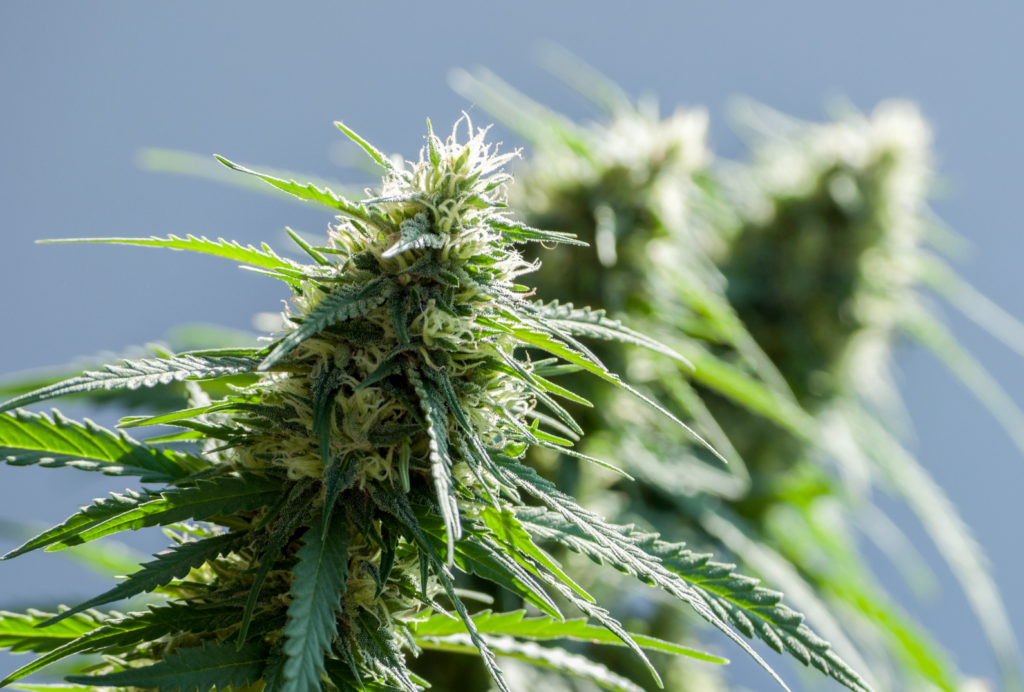This website requires you to be 21 years or older to enter. Please confirm your age below to continue.

In the last segment I discussed Ocimene which is known for its antifungal, antiviral, and anti-inflammatory effects. In this article I will discuss Limonene, one of the most abundant and prevalent terpenes on Earth.
Understanding Limonene?
Terpenes do more than dictate the taste and smell of cannabis. Research shows terpenes are healers in their own right and are capable of altering the strength and effect of other components of the cannabis plant, including cannabinoids like THC and CBD.
Limonene (lim-o-neen), commonly known as d-limonene, is a monoterpene that has been used for centuries as a natural treatment for multiple health issues. In nature, you’ll find it in pine, mint, juniper, rosemary, the peels of citrus fruits, and essential oils like lemon oil and orange oil. In food, it’s used as a flavoring. At home, you’ll find it in everything from anti-acne skin treatments to cleaning and pesticide products. In medicine, you’ll find limonene in pharmaceutical and herbal treatments alike.
The Entourage Effect: How Limonene interacts with other Cannabinoids
Doctor Ethan Russo explains in his 2011 study, cannabinoids and terpenes work synergistically in the human body to modify one another’s effects to create an overall different, or “greater,” efficacy based on the same molecules present and, of equal importance, the ratios in which they appear.
As part of the entourage effect, limonene interacts with several cannabinoids including CBDa, CBCa, THCa, CBG, and CBC. It also functions alongside other terpenes such as b-caryophyllene and linalool to positively impact the effect of cannabis strains containing these terpenes. Limonene is known to allow more efficient absorption of other cannabis terpenes, making it a critical component in the overall effect unique to each strain.
One of limonene’s significant properties is reducing the anxiety that can be produced by THC as well as producing a feeling of well-being.
Despite limonene’s potential therapeutic benefits, little is known about how it works in the brain and body, and what doses are required to achieve these benefits.
By better understanding limonene’s targets in the brain and body, scientists may help direct users towards strains or products where limonene’s therapeutic benefits are optimized by a particular cannabinoid and terpene profile.
Limonene benefits
A variety of research studies support the medicinal efficacy of limonene. Research has already demonstrated its antifungal, antibacterial, antioxidant, and anti-inflammatory properties, useful for patients suffering from a wide range of conditions. Here are just a few examples of health issues limonene helps with.

Limonene is also added to medicinal ointments and creams to help other ingredients penetrate the skin.
Strains high in limonene
Limonene levels make up a small part of the cannabis terpene profile. Typically, trace amounts of limonene can be found in dozens of strains. A few (usually sativa-dominant) strains express higher levels of limonene than others – and even the same strain can vary across harvests – but you’ll most likely find it in:

Limonene is highly volatile (easily evaporates) making pure limonene oil ideal for inhaled aromatherapy, for those who’d rather not smoke it. Inhalation of limonene vapor increases serotonin and dopamine levels in key regions of the brain that are associated with anxiety, depression, and OCD.
Whether you buy high-limonene strains or use as aromatherapy – you get the added benefit of enhancing other parts of the plant to treat more (or more complex) health conditions. For example, limonene’s anti-inflammatory and antibacterial effects can boost similar properties in CBD.
Safety and side effects
Limonene is considered safe for humans with little risk of side effects. The Food and Drug Administration (FDA) recognizes limonene as a safe food additive and flavoring. However, when applied directly to the skin, limonene may cause irritation in some people, so caution should be used when handling its essential oil.
Limonene is broken down by many of the same liver enzymes that other drugs use for metabolization. Because of this, limonene may increase or decrease the concentration of certain drugs as they compete for the same enzyme—namely, cytochrome P450 (CYP450).
It’s best to consult your healthcare practitioner before taking limonene supplements, especially if you’re taking medications, are pregnant or breastfeeding, or have a medical condition.
Conclusion
New research continues to reveal more about the many ways these cannabis components work with each other and the body’s own systems to help combat disease and promote wellbeing to bring relief to many health conditions.
References
Araújo-Filho, H. G., Pereira, E., Rezende, M. M., Menezes, P. P., Araújo, A., Barreto, R., Martins, A., Albuquerque, T. R., Silva, B., Alcantara, I. S., Coutinho, H., Menezes, I., Quintans-Júnior, L. J., & Quintans, J. (2017). D-limonene exhibits superior antihyperalgesic effects in a β-cyclodextrin-complexed form in chronic musculoskeletal pain reducing protein expression on spinal cord in mice. Neuroscience, 358, 158–169. https://doi.org/10.1016/j.neuroscience.2017.06.037
Costa, C. A., Cury, T. C., Cassettari, B. O., Takahira, R. K., Flório, J. C., & Costa, M. (2013). Citrus aurantium L. essential oil exhibits anxiolytic-like activity mediated by 5-HT(1A)-receptors and reduces cholesterol after repeated oral treatment. BMC complementary and alternative medicine, 13, 42. https://doi.org/10.1186/1472-6882-13-42
d’Alessio, P. A., Mirshahi, M., Bisson, J. F., & Bene, M. C. (2014). Skin repair properties of d-Limonene and perillyl alcohol in murine models. Anti-inflammatory & anti-allergy agents in medicinal chemistry, 13(1), 29–35. https://doi.org/10.2174/18715230113126660021
d’Alessio, P. A., Ostan, R., Bisson, J. F., Schulzke, J. D., Ursini, M. V., & Béné, M. C. (2013). Oral administration of d-limonene controls inflammation in rat colitis and displays anti-inflammatory properties as diet supplementation in humans. Life sciences, 92(24-26), 1151–1156. https://doi.org/10.1016/j.lfs.2013.04.013
de Almeida, A. A., Costa, J. P., de Carvalho, R. B., de Sousa, D. P., & de Freitas, R. M. (2012). Evaluation of acute toxicity of a natural compound (+)-limonene epoxide and its anxiolytic-like action. Brain research, 1448, 56–62. https://doi.org/10.1016/j.brainres.2012.01.070
do Vale, T. G., Furtado, E. C., Santos, J. G., Jr, & Viana, G. S. (2002). Central effects of citral, myrcene and limonene, constituents of essential oil chemotypes from Lippia alba (Mill.) n.e. Brown. Phytomedicine : international journal of phytotherapy and phytopharmacology, 9(8), 709–714. https://doi.org/10.1078/094471102321621304
Hartsel, J., Eades, J., Hickory, B., & Makriyannis, A. (2016, February 19). Cannabis sativa and Hemp. Retrieved October 15, 2020, from https://www.sciencedirect.com/science/article/pii/B978012802147700053X
Hirota, R., Roger, N. N., Nakamura, H., Song, H. S., Sawamura, M., & Suganuma, N. (2010). Anti-inflammatory effects of limonene from yuzu (Citrus junos Tanaka) essential oil on eosinophils. Journal of food science, 75(3), H87–H92. https://doi.org/10.1111/j.1750-3841.2010.01541.x
Kim, T., Song, B., Cho, K. S., & Lee, I. S. (2020). Therapeutic Potential of Volatile Terpenes and Terpenoids from Forests for Inflammatory Diseases. International journal of molecular sciences, 21(6), 2187. https://doi.org/10.3390/ijms21062187
Komiya, M., Takeuchi, T., & Harada, E. (2006). Lemon oil vapor causes an anti-stress effect via modulating the 5-HT and DA activities in mice. Behavioural brain research, 172(2), 240–249. https://doi.org/10.1016/j.bbr.2006.05.006
Miller, J. A., Lang, J. E., Ley, M., Nagle, R., Hsu, C. H., Thompson, P. A., Cordova, C., Waer, A., & Chow, H. H. (2013). Human breast tissue disposition and bioactivity of limonene in women with early-stage breast cancer. Cancer prevention research (Philadelphia, Pa.), 6(6), 577–584. https://doi.org/10.1158/1940-6207.CAPR-12-0452
Mizrahi, B., Shapira, L., Domb, A. J., & Houri-Haddad, Y. (2006). Citrus oil and MgCl2 as antibacterial and anti-inflammatory agents. Journal of periodontology, 77(6), 963–968. https://doi.org/10.1902/jop.2006.050278
Rehman, M. U., Tahir, M., Khan, A. Q., Khan, R., Oday-O-Hamiza, Lateef, A., Hassan, S. K., Rashid, S., Ali, N., Zeeshan, M., & Sultana, S. (2014). D-limonene suppresses doxorubicin-induced oxidative stress and inflammation via repression of COX-2, iNOS, and NFκB in kidneys of Wistar rats. Experimental biology and medicine (Maywood, N.J.), 239(4), 465–476. https://doi.org/10.1177/1535370213520112
Research Campaign Phase I/II Clinical Trials Committee. Cancer chemotherapy and pharmacology, 42(2), 111–117. https://doi.org/10.1007/s002800050793
Russo, E. B., & Marcu, J. (2017). Cannabis Pharmacology: The Usual Suspects and a Few Promising Leads. Advances in pharmacology (San Diego, Calif.), 80, 67–134. https://doi.org/10.1016/bs.apha.2017.03.004
Sun J. (2007). D-Limonene: safety and clinical applications. Alternative medicine review : a journal of clinical therapeutic, 12(3), 259–264. https://pubmed.ncbi.nlm.nih.gov/18072821/
Vigushin, D. M., Poon, G. K., Boddy, A., English, J., Halbert, G. W., Pagonis, C., Jarman, M., & Coombes, R. C. (1998). Phase I and pharmacokinetic study of D-limonene in patients with advanced cancer. Cancer Research Campaign Phase I/II Clinical Trials Committee. Cancer chemotherapy and pharmacology, 42(2), 111–117. https://doi.org/10.1007/s002800050793
Wang, X., Li, G., & Shen, W. (2018). Protective effects of D-Limonene against transient cerebral ischemia in stroke-prone spontaneously hypertensive rats. Experimental and therapeutic medicine, 15(1), 699–706. https://doi.org/10.3892/etm.2017.5509
Yoon, W. J., Lee, N. H., & Hyun, C. G. (2010). Limonene suppresses lipopolysaccharide-induced production of nitric oxide, prostaglandin E2, and pro-inflammatory cytokines in RAW 264.7 macrophages. Journal of oleo science, 59(8), 415–421. https://doi.org/10.5650/jos.59.415
Yu, L., Yan, J., & Sun, Z. (2017). D-limonene exhibits anti-inflammatory and antioxidant properties in an ulcerative colitis rat model via regulation of iNOS, COX-2, PGE2 and ERK signaling pathways. Molecular medicine reports, 15(4), 2339–2346. https://doi.org/10.3892/mmr.2017.6241